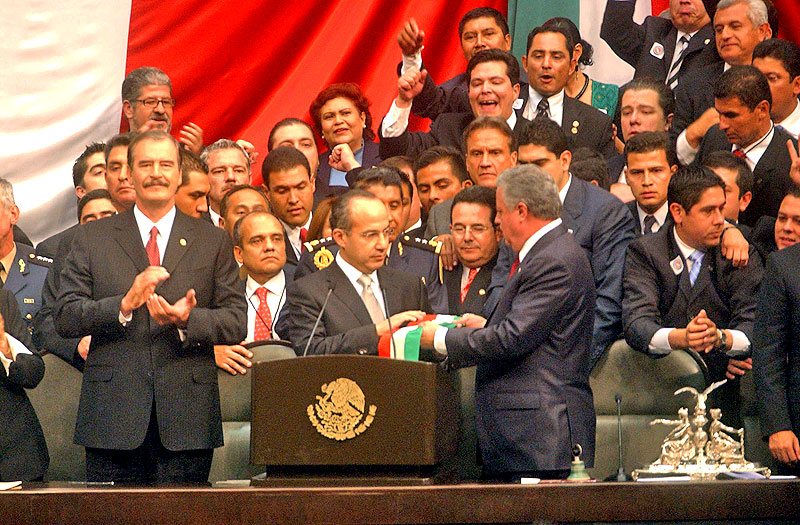2006
01/01/2007
ANALYSIS: Mexico – New Governments, old Issues
30/03/20072006
19 January 2006: the Unitary Agrarian Tribunal in Acapulco, Guerrero, resolves to cancel the San Marcos Assembly that was held on August 23, 2005, because of the evident irregularities found. One, among other irregularities was the apparent absence of notification announcing the assembly, a violation of the Agrarian Law.
1 March 2006: a legal demand is filed for the Unitary Agrarian Tribunal (TUA) to annul collective-land assemblies from Dos Arroyos, La Palma and Los Huajes where decisions guaranteeing the expropriation in favor of La Parota Hydroelectric Project were taken.
April: the Other Campaign (La Otra Campaña) headed by Delegate Zero (Delegado Zero) visits Guerrero, including historical places of the struggle and resistance in the state. Subcommander Marcos offers the support of the Zapatista communities and the EZLN to the movement in opposition to La Parota Dam.
9 May 2006: the state governor, Zeferino Torreblanca Galinda, heads a march with various townspeople in favor of the hydroelectric dam project, La Parota. About 2,000 people, the majority members of the Council of Ejidos and Communities Opposed to La Parota Dam (CECOP), respond with another march on May 14th in order to show that they are not the minority, as well as,to denounce that the governor does not have a neutral position regarding the project.
29 May 2006: The environmentalist Felipe Arreaga denounces that he was the victim of abuses carried out by military soldiers that were part of a revision checkpoint in the community of La Botella, located in the Sierra of Petatlán.
5 June 2006: President Vicente Fox awards Felipe Arreaga with the Environmental Merit Award in Chihuahua.
Beginning of June: Abuse of authority, violations of labor rights, arbitrary detentions, and the denial of the right to education, are the most reccurring human rights violations in Guerrero in accordance with the 12th report from the Tlachinollan Mountain Center for Human Rights.
10 to 13 August 2006: the United Nations Special Rapporteur on the situation of human rights and fundamental freedoms of Indigenous peoples, Rodolfo Stavenhagen, visits Guerrero. He indicates that the government has “the obligation to protect the human rights of the inhabitants who are in opposition to the La Parota project.” He also manages to get many testimonies of indigenous peoples who have denounced violations against human rights. The cases are related to extra-judicial killings, sexual abuse by military personnel, land evictions, and the shortage of public services.
27 September 2006: workers from the Federal Electricity Commission (CFE) involved in the construction of La Parota, are suspended by order of a Third District judge, as well as, the processes to expropriate the land in La Palma, Los Huajes and Dos Arroyos, which together with Cacahuatepec, represent 67% of the surface land falling within the boundaries of the hydroelectric dam.
1 October 2006: at least 30 grass-roots organizations and trade unions create the Popular Assembly of the Peoples of Guerrero (APPG).
October: authorities and inhabitants of Barranca de Guadalupe in the municipality of Ayutla, as well as the Organization of the Me’Phaa Indigenous Peoples (OPIM) denounce that troops entered their community, established camp on a parcel of land, destroyed the hose that supplies the community’s water, and cut and ate corn belonging to the community. The Tlachinollan Mountain Center for Human Rights also denounces the increasing presence of military in indigenous communities of La Montaña and la Costa Chica. Denouncements made by Me’Paa indigenous peoples concerning the presence of troops, the damage they caused, the sexual harassment and threats to which they fell victims in the communities of Progreso and Barranca de Guadelupe, and the denouncements made by the Community Police regarding the military occupation of their territory, particularly in San Luis Acatlán, form part of this trend.
6 December 2006: the Mexican president, Felipe Calderón Hinojosa, states in his first tour through Guerrero that, “beyond colors and parties”, there is only one Mexico “that is drowned in poverty and marginalization, and demand political actors get to work on these issues.” Governor Torreblanca (PRD) accompanies him during the tour. Calderón recognizes “the responsibility, the hospitality, and consistency of the State Governor Zeferino Torreblanaca,” guaranteeing him: “You can undoubtedly count on me, Mr. Governor, during my government.”
11 December 2006: The Secretary of the State informs that the army, marines, state and investigative police (PIM) have been patrolling the region of Tierra Caliente and Costa Grande in order to avoid narcotraffickers seeking refuge in Guerrero to do so as a result of the Operation Michoacán, which is carried out in the neighboring state.
December: opposers of La Parota and Tlachinollan Human Rights Center denounce that Governor Zeferino Torreblanca approved the construction of the roads between Dos Arroyos and Agua de Perro, as well as in Tunzingo behind closed doors and with resources of the CFE, in places where the Unitary Agrarian Tribunal prohibited this. They show with this that the governor, along with the CFE violated the law and are provoking a confrontation between community members. The Secretary of the State, Armando Chavarría Barrera, denies these accusations.
